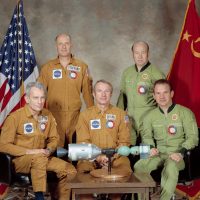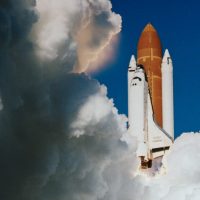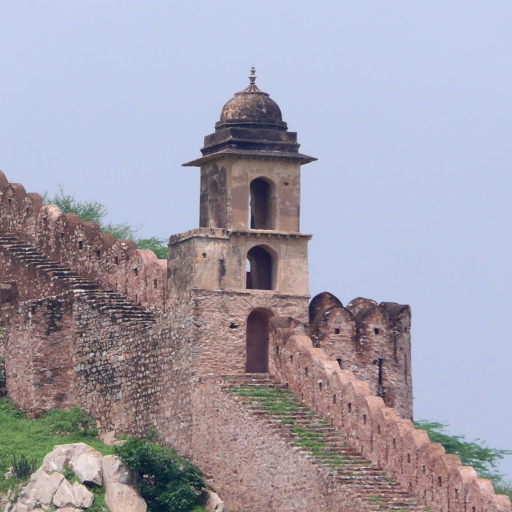Listen to this post as a podcast:

Soyuz MS-17/Expedition 64 takes off from Baikonur Cosmodrome in Kazakhstan on October 14, 2020. (Image credit: NASA/GCTC/Andrey Shelepin.)
This month, two crewed Soyuz spacecraft have carried astronauts between Earth and the International Space Station. On Wednesday, October 14, a Soyuz rocket took off from Kazakhstan carrying one American astronaut, Kate Rubins, and two Russian cosmonauts, Sergey Ryzhikov and Sergey Kud-Sverchkov. The Soyuz spacecraft docked with the International Space Station later that day. The next week, another Soyuz spacecraft carried the previous station crew back to Earth for a landing on the Kazakhstan steppe.
I watched both the launch and the landing on NASA TV, and they got me thinking about technological continuity in the Russian space program. Here it was 2020, and I was watching the flight of a spacecraft design, the Soyuz, which first flew more than a half-century earlier in 1967. The Soyuz booster has three stages; the first two stages, the conical strap-on boosters and the core stage, are based on the R-7 ICBM, which made its first test flight in 1967 and launched Sputnik 1 in October of that year. The rocket thus represents an unbroken technological link to the very beginning of the Space Age.
Compare this to NASA. NASA’s Apollo spacecraft, which made its first crewed flight in 1968, was retired in 1975 to be replaced by the Space Shuttle, a completely new design. The Shuttle, in turn, was retired in 2011. NASA is now going back to the capsule format of Apollo but with an entirely new spacecraft, Orion, currently scheduled to fly its first crewed mission sometime in 2023. Meanwhile the Russians have been flying one version or another of the Soyuz this whole time.
It is possible to over-emphasize continuity in Russian spaceflight, as the Russians have made their share of technological leaps as well. As Asif Siddiqi notes in Challenge to Apollo, both the R-7 booster and the Soyuz were themselves technological leaps. The R-7 was the world’s first intercontinental ballistic missile, bigger and more powerful than anything built before it. The Soyuz, too, was bigger and much more versatile than the spacecraft that preceded it, Vostok and Voskhod. The Russians also expended great amounts of money and human effort on other programs that would also have been technological leaps if they had succeeded or gone into operation, like the N-1 moon rocket (canceled after four unsuccessful test flights) and the Energiya booster (abandoned during the fall of the Soviet Union).
I should also note that the Soyuz of 2020 is different in many ways from the Soyuz of 1967. While the external appearance has changed little in the past fifty years, Russian engineers have made big changes under the hood. The early Soyuz were unreliable and dangerous, leading to numerous failed missions and two flights that ended in tragedy. But over the past 53 years, the Soyuz has been redesigned for greater reliability and safety.
I think it’s interesting how the Russians are comfortable with perfecting a proven design, rather than throwing away the old in favor of something new, as we like to do in the United States. True, the Soyuz rocket is ungainly and uses low-energy propellants (kerosene and liquid oxygen), and the Soyuz spacecraft is clunky and cramped. Yet both are now very reliable, having had their kinks worked out in more than fifty years’ worth of flights. NASA never could have said the same about the Space Shuttle.





Suzan Logan
I really liked listening to your podcast! You have a very nice voice that makes comfortable listening.
Willy
Thank you! I’m glad you enjoyed listening to it.